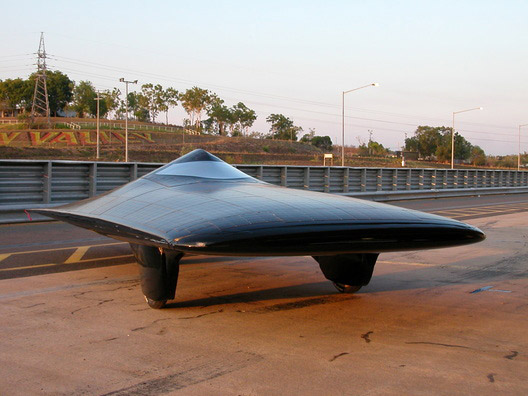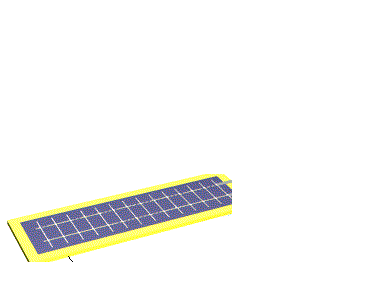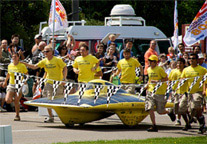Lesson: Design and Race a Solar Car
(Provided courtesy of the National Science Digital Library and WPSU) Click HERE for TeachEngineering activity, which includes alignment with state science standards and NGSS.
In this design challenge for grades 6 to 8, students will harness the power of the sun to design, construct and evaluate a solar-powered model car of their creation. Students will utilize the design process and undergo review by their peers to select an optimal gear ratio and components for their car. As a culminating activity, students compete in a “Solar Sprint” race modeled after the National Renewable Energy Laboratory’s Junior Solar Sprint competition.
Grade Level: 6 – 8
Time: 150 minutes
Content Objectives
Students will know that solar energy is a renewable energy source, and its utilization has numerous benefits for our environment.
The angle at which a solar cell is positioned in relation to the sun affects its power output.
The amount of current produced by a photovoltaic cell is proportional to the amount of the light hitting the cell; therefore, increasing light intensity or increasing the size of the cell itself will increase the power output of the cell.
In order to construct a solar powered system that will work at maximum efficiency, numerous factors pertaining to the design, such as gear ratio and power output, must be considered.
Process Objectives
Students will be able to
- Describe three factors influencing a solar car’s power needs: friction, air drag, and acceleration.
- Calculate the gear ratio used in the drive system of their solar powered car.
- Describe the motion of their solar car based upon its position, direction, and speed.
- Explain how the solar car design was optimized based upon gear ratio and materials used.
- Utilize the design process to construct a solar-powered car.

Suggested Time
Four to ten (4-10) 50-minute class periods.
Materials
Per Group:
- Solar Sprint kit (from http://www.nrel.gov/education/kits.html)
- Solar Sprint accessories kit (from http://www.nrel.gov/education/kits.html)
- Various reused materials to construct a body for the car (foam core, Blue board, wood, corrugated cardboard)
- Stopwatch
- Solar Racing Student Handout PDF Document (http://www.pspb.org/e21/media/Solar_Racing_v105_SH.pdf)
Instead of purchasing Solar Sprint kits, many accessories can be extracted from old toys, VCRs, tape recorders, old “Spirograph” gears and reused as shafts, wheels and gears.
Teacher Tools:
- Solar Racing Teacher’s Notes PDF Document
- Soldering Iron
- Sharp Utility Knife or Coping Saw
- Cool-Melt Glue Gun
- Needle-Nose Pliers
- 1/8″ Drill Bit or Electric Drill with Bit
- 2 C-Clamps
- Rulers
- Pencils
- Wire Strippers and Wire Cutters
Multimedia Resources
- Solar and Car Fundamentals PowerPoint Document (http://www.pspb.org/e21/media/MS_S05_Andy_Lau.ppt)
- Build Junior Sprint Car PowerPoint Document (http://www.pspb.org/e21/media/build_junior_sprint_car.ppt)

The Lesson
Part I: The Design Process (One 50-minute Class Period)
1. Introduce students to the U.S. Department of Energy’s contest, Junior Solar Sprint using background information and rules from this website: www.nrel.gov/education/jss_hfc.html.
2. Allow them to get into teams and select a name, colors and number, etc.
3. Briefly describe the components of the solar car (Solar panel, Chassis; Wheels, Axles and Bearings; Transmissions; Body Shells) about which students will be able to make design choices. If your students have not worked with solar panels previously, you may need to spend more time discussing and exploring how a solar panel works.
4. Share the Design Process diagram, Figure 1 in the Solar Racing Teacher’s Notes PDF Document and on page 1 of the Solar Racing Student Handout PDF Document with students and give them a general overview of where and when they will apply the steps of the process in making their cars.
The Chimacum School district Junior Solar Sprint website has an excellent description of how each step of the design process is connected to building successful solar cars. It can be accessed at the link below:
http://eagle.csd49.org/middle/jss/Course_DsgnProc.htm
5. Allow teams to work together to get their initial car concepts onto paper and prompt them to generate a list of questions they have before they can select a design.
6. Be sure that your students are clear about the task before them. Make sure that you articulate that the students should be thinking about the design of the chassis, wheels and bearing, body and the solar energy source.
Part II: Experiment with Principles and Prototypes (1 or 2-50 minute Class Periods)
7. Field any questions students have generated and share the PowerPoint presentation below with your students, highlighting the concepts that direct the goals of the solar-powered car project.
Solar and Car Fundamentals PowerPoint Document http://www.pspb.org/e21/media/MS_S05_Andy_Lau.ppt
8. Focus specifically on how to calculate gear ratio and give students team-time to make decisions about their transmissions and work through the Gear Ratio calculations section beginning on page 4 of the student handout.
9. Allow students to return to teams to further time to conceptualize their design and prepare for their class presentation.
Part III: Design Review and Solar-Powered Car Construction (Multiple Class Periods)
10. Allow teams to complete page 9 of the student handout and make presentations of their designs to their classmates that explain their decisions regarding the four major car components (transmission, chassis, wheels and bearings, body and Photovoltaic array) with a rationale for each.
11. After teams have taken time to revisit the “drawing board” on page 10 of the PDF below, set them off to construct their cars.
(A materials list for tools is also included. If students will be using any tools, instruct them to make safety a priority.) Solar Racing Student Handout PDF Document (http://www.pspb.org/e21/media/Solar_Racing_v105_SH.pdf)
12. Encourage and allow time for some test runs. If you are lacking sun, halogen lamps work well to power cars in a short distance test-track area.
Part IV: Design Test: Solar Racing! (1-50 minute Class Period) 
13. Get ready to race. Spend some time prior to race day looking at the following website:
http://eagle.chimacum.wednet.edu/middle/jss/Course_Rules.htm for information on official rules for the contest. The Chimacum School District Junior Solar Sprint website is a wonderful all-around resource. If you are interested in spending a full two weeks on the project, an extensive model program for creating solar-powered cars with embedded investigations on each stage of the design process is available.
14. Celebrate the teams’ design successes with a solar-power awards ceremony.
Part V: Make Connections: What other applications can the sun power? (20 minutes)
15. Debrief the project and allow teams to work together to complete Part 5 of the Solar Racing Student Handout PDF Document.
16. Spend time as a class sharing ideas and reflecting upon how technology and science solutions impact our society.
Part VI: Extension
17. Apply solar-powered car knowledge to designing a component for a home such as a solar water heater using a 16-ounce bottle of water.
Watch video of the Junior Sprint Solar Competition – at top of screen – on YouTube: http://www.youtube.com/watch?v=6xXtleFh2ls
Assessment Strategies
- Evaluation of the completed student handouts and of the student’s participation in class discussions.
- Observation of student’s participation throughout the process of designing a solar car.
- Student participation in a team presentation of their solar-powered car design.
- Completion of the student’s solar car design evaluation.
Additional Resources
http://www.nrel.gov/education/jss_hfc.html
National Renewable Energy Laboratory (NREL) Education page on Junior Solar Sprint Competition.
http://eagle.chimacum.wednet.edu/middle/jss/index.htm
Suggested JSS lessons and background information on solar power.
http://eagle.csd49.org/middle/jss/Course_DsgnProc.htm
For more information on Using the Design Process.
http://www.teachersdomain.org/resource/psu06-e21.sci.solarracing/
Lesson Plan: Solar Racing
Filed under: Grades 6-8, Lesson Plans
Tags: Cars, Class Activities, Competitions for Students, Grades 6-8, renewable energy, Solar Engineering








